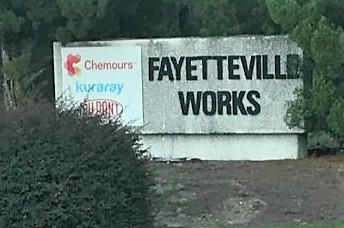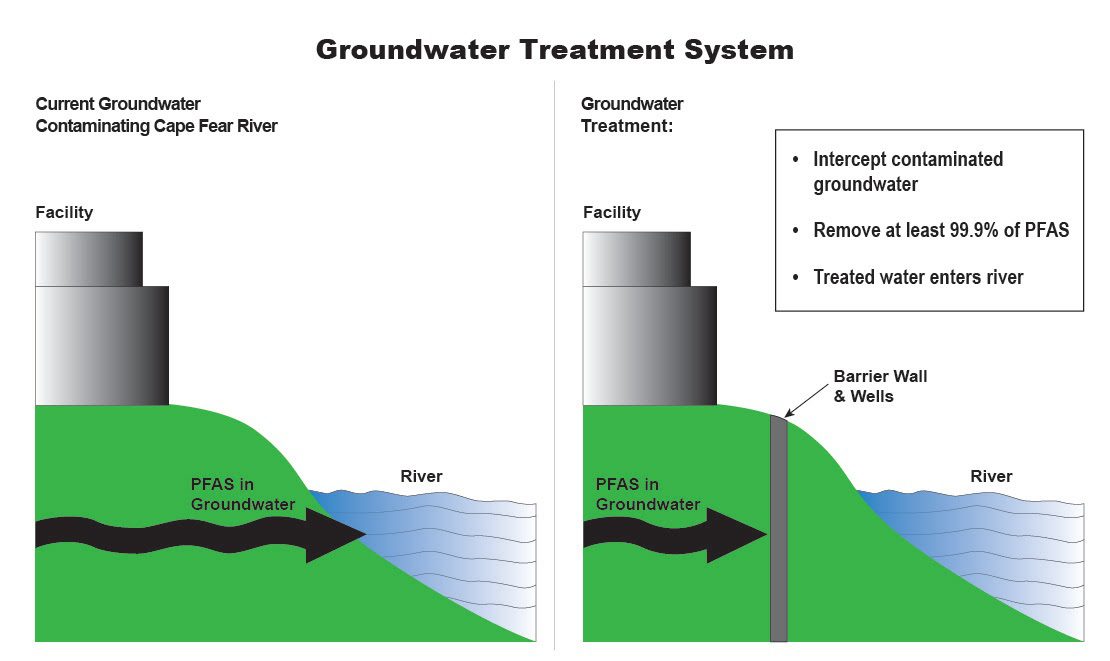
This post has been updated.
A draft discharge permit announced earlier this year for a treatment system to remove contaminants from groundwater on the Chemours Fayetteville Works site met opposition, but the final permit announced last week has been well-received, for the most part, by environmental advocates.
Supporter Spotlight
The North Carolina Department of Environmental Quality’s Division of Water Resources issued the National Pollutant Discharge Elimination System, or NPDES, permit Thursday for a granular activated carbon, or GAC, filtration treatment system. The system is to treat groundwater, surface water and stormwater contaminated by perfluoroalkyl and polyfluoroalkyl substances before it can reach the Cape Fear River, a drinking water source for hundreds of thousands in the Wilmington area.
“This is an important step in addressing the largest ongoing source of #pfas contamination to the Cape Fear River,” Secretary Biser said Thursday on Twitter, adding that the state Department of Environmental Quality, “remains committed to holding polluters accountable and protecting water quality for all North Carolinians.”

PFAS are a large group of manufactured chemicals found in everyday products like nonstick cookware and carpeting. The Wilmington StarNews reported in June 2017 that the chemical was detected in the Cape Fear River by N.C. State University scientists. An investigation linked the chemicals to the Chemours facility in Fayetteville. Chemours has been prohibited since from discharging PFAS-contaminated process wastewater from its manufacturing operations into the river, but there is significant groundwater contamination, according to DEQ.
During an initial period to adjust the performance of the system, the permit limits will be 120 parts per trillion, or ppt, for GenX, 100 ppt for perfluoro-2-methoxypropanoic acid, or PMPA, and 320 ppt for perfluoro-2-methoxyacetic acid, or PFMOAA. After the 180-day optimization period, the limits are to drop to less than 10 ppt for GenX, 10 ppt for PMPA and less than 20 ppt for PFMOAA.
The limits represent an estimated removal efficiency of greater than 99.9%, officials said Thursday.
Supporter Spotlight
The treatment system is part of the greater barrier wall remediation project, outlined in the 2020 addendum to the 2019 consent order signed by Cape Fear River Watch, Chemours and DEQ. The consent order requires Chemours to stop GenX and other PFAS pollution, provide clean drinking water for those with contaminated wells, and ensure the Cape Fear River is safe for downstream communities.
Cape Fear River Watch and Southern Environmental Law Center representatives said Friday that the permit as issued “sets the strongest limits on discharges of toxic PFAS pollution in the United States,” after the two groups and many residents urged the agency to strengthen the permit.
When the earlier draft permit was released March 25, the groups submitted comments in May and June to NCDEQ that pushed for the changes now reflected in the final permit.
“The massive remediation project is the largest of its kind to address PFA,” DEQ officials said Thursday. “Currently, the contaminated groundwater flows untreated directly into the Cape Fear River. This project is designed to reduce the largest ongoing source of PFAS contaminating the river and reaching downstream water intakes and must be operational by March 15, 2023.”
The remediation project involves a milelong underground barrier wall running parallel to the river and more than 70 extraction wells. The groundwater is to be pumped and treated to remove an estimated 99.9% of PFAS compounds before being released into the river. DEQ issued an approval letter for the barrier wall design with conditions for additional monitoring wells, sampling of extraction wells and management of contaminated groundwater during barrier wall construction.
The earlier draft permit released in March drew public response because it “would have authorized significantly more PFAS pollution from the groundwater treatment system — a treatment system required under the consent order negotiated by the Southern Environmental Law Center, on behalf of Cape Fear River Watch, with the Department of Environmental Quality, and Chemours,” the law center announced Friday.
The first public comment period was March 24 to May 2. DEQ on May 17 announced public meetings to be held in June and that the division would continue to accept comments until June 24. During that time, the division received 250 written comments supporting the draft permit, most apparently copied from one website with identical text, and 155 comments opposing the draft. During the two hearings, about 140 attended with 33 speaking against the proposed permit.
State officials said Thursday that after considering public comments and further review of data and information contained in the permit record, the permit limits for the three indicator compounds had been “significantly reduced beyond the 99% removal required” in the consent order.
“Enforcing existing law to require that the polluter, Chemours, nearly eliminate PFAS pollution from its discharge into a major drinking water source for over 300,000 North Carolinians is an important milestone in the fight to stop PFAS pollution,” said Geoff Gisler, senior attorney at the Southern Environmental Law Center. “DEQ listened to the community by issuing a permit that ensures Chemours will use the best available technology to nearly eliminate PFAS from its new treatment system, protecting the Cape Fear River and families downstream.”
Cape Fear River Watch Executive Director Dana Sargent told Coastal Review Friday that the tighter restrictions amounted to “a big win.”
She added that the organization was grateful that people made their voices heard by submitting hundreds of comments to DEQ. “DEQ heard their outrage and heartache,” and is enforcing the law in limiting Chemours’ PFAS discharge based on capabilities of available technology.
“This is a big one for us as we know we would never have gotten here without the consent order and we have been begging DEQ to enforce technology-based effluent limitations for quite some time,” she said.
Cape Fear Public Utility Authority Communications Director Vaughn Hagerty said Friday that authority staff is still looking at the final permit and related materials.
“I can say that while we and the community we serve would prefer no PFAS from Chemours in the discharge governed by this permit, it does appear as though the discharge limits in the final permit are lower than what had been proposed in the draft permit released a few months ago. We’re grateful to our partners at DEQ for not only listening to our community’s concerns but reflecting those concerns in writing the final permit,” he said.
Sargent said that when her organization sued Chemours, the company was required to find ways to drastically reduce their discharge and through the granular activated carbon system installed at the old outfall, data has proven the technology can reduce discharge to near undetectable levels. At the levels DEQ is enforcing in the permit, Chemours must maintain the system to the utmost, essentially limiting PFAS discharge from the groundwater on site to near undetectable levels.
The issue with DEQ’s earlier draft at 99% reduction was that it would have allowed Chemours to get away with not maintaining the granular activated carbon system, “spending as little money as possible and allowing discharge,” she added.
Clean Cape Fear officials also noted the permit announcement via a social media post Thursday.
“We asked for zero PFAS–DEQ said at least 99.9%. While we are grateful for these protections–we believe if Chemours can capture 99.9% — then Chemours should be required to capture 100%,” according to the post. “Friendly reminder, the current high levels of PFAS we regularly see in our tap water are coming from severely toxic groundwater underneath the Chemours facility in Fayetteville. This new permit is part of the barrier wall project Chemours is required to install to limit their PFAS releases into our river.”
In addition to setting limits for the three indicator compounds, the permit includes weekly monitoring of the treatment system during barrier wall construction and an evaluation a year later to add any new information. The permit can also be reopened to add limitations based on new toxicity data, introduction of federal or state PFAS standards, and if another PFAS compound breaks through the treatment system more quickly than the three current indicator parameters, officials said.
A representative from Chemours said Friday that the company was in the process of reviewing the information.








